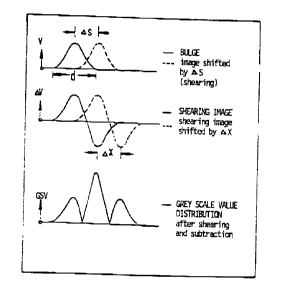Une partie des informations de ce site Web a été fournie par des sources externes. Le gouvernement du Canada n'assume aucune responsabilité concernant la précision, l'actualité ou la fiabilité des informations fournies par les sources externes. Les utilisateurs qui désirent employer cette information devraient consulter directement la source des informations. Le contenu fourni par les sources externes n'est pas assujetti aux exigences sur les langues officielles, la protection des renseignements personnels et l'accessibilité.
L'apparition de différences dans le texte et l'image des Revendications et de l'Abrégé dépend du moment auquel le document est publié. Les textes des Revendications et de l'Abrégé sont affichés :
| (12) Brevet: | (11) CA 2185572 |
|---|---|
| (54) Titre français: | PROCEDE DE TRAITEMENT D'IMAGE PERMETTANT DE DETERMINER LA RESISTANCE STRUCTURALE D'UN OBJET A TESTER PRESENTANT UNE SURFACE A DISPERSION DIFFUSE |
| (54) Titre anglais: | IMAGE PROCESSING METHOD FOR DETERMINING THE STRUCTURAL STRENGTH OF A TEST OBJECT WITH A DIFFUSE-SCATTERING SURFACE |
| Statut: | Réputé périmé |
| (51) Classification internationale des brevets (CIB): |
|
|---|---|
| (72) Inventeurs : |
|
| (73) Titulaires : |
|
| (71) Demandeurs : | |
| (74) Agent: | NORTON ROSE FULBRIGHT CANADA LLP/S.E.N.C.R.L., S.R.L. |
| (74) Co-agent: | |
| (45) Délivré: | 2002-09-03 |
| (86) Date de dépôt PCT: | 1996-01-15 |
| (87) Mise à la disponibilité du public: | 1996-07-25 |
| Requête d'examen: | 1996-09-13 |
| Licence disponible: | S.O. |
| (25) Langue des documents déposés: | Anglais |
| Traité de coopération en matière de brevets (PCT): | Oui |
|---|---|
| (86) Numéro de la demande PCT: | PCT/EP1996/000187 |
| (87) Numéro de publication internationale PCT: | WO1996/022507 |
| (85) Entrée nationale: | 1996-09-13 |
| (30) Données de priorité de la demande: | ||||||
|---|---|---|---|---|---|---|
|
L'invention concerne un procédé de traitement d'image permettant de déterminer la résistance structurale d'un objet à tester présentant une surface à dispersion diffuse. Ce procédé consiste à établir un interférogramme sur la base du rayonnement redispersé par la surface de l'objet à tester, à convertir cet interférogramme en une image modulo-2.pi. et à stabiliser cette image modulo-2.pi. en une image initiale présentant une valeur de gris, qui permet de produire une copie d'image à valeur de gris identique. Ce procédé consiste ensuite à effectuer une translation géométrique de cette dernière image, à la modifier d'une valeur de gris constante sur l'ensemble de la zone d'image et enfin à soustraire la copie de l'image à valeur de gris ainsi modifiée, de l'image initiale à valeur de gris pour obtenir une image à valeur de gris contenant des informations facilement exploitables sur les déformations de l'objet à tester observé.
The proposed image-processing method for determining the structural strength of
a test object with a diffuse-scattering surface involves: the creation of an interferogram
based on radiation back-scattered by the surface of the test object; conversion of the
interferogram into a modulo-2.pi. image; and the stabilisation of the modulo-2.pi. image to
form an output grey scale value image. From the latter, an identical duplicate grey scale
value image is produced; this is then geometrically shifted and modified by applying
an invariable grey scale value in the entire image area, before being finally subtracted
from the initial grey scale value image to produce a grey scale image containing easily
evaluated information on deformities in the observed test object.
Note : Les revendications sont présentées dans la langue officielle dans laquelle elles ont été soumises.
Note : Les descriptions sont présentées dans la langue officielle dans laquelle elles ont été soumises.

Pour une meilleure compréhension de l'état de la demande ou brevet qui figure sur cette page, la rubrique Mise en garde , et les descriptions de Brevet , États administratifs , Taxes périodiques et Historique des paiements devraient être consultées.
| Titre | Date |
|---|---|
| Date de délivrance prévu | 2002-09-03 |
| (86) Date de dépôt PCT | 1996-01-15 |
| (87) Date de publication PCT | 1996-07-25 |
| (85) Entrée nationale | 1996-09-13 |
| Requête d'examen | 1996-09-13 |
| (45) Délivré | 2002-09-03 |
| Réputé périmé | 2007-01-15 |
Il n'y a pas d'historique d'abandonnement
| Type de taxes | Anniversaire | Échéance | Montant payé | Date payée |
|---|---|---|---|---|
| Requête d'examen | 400,00 $ | 1996-09-13 | ||
| Le dépôt d'une demande de brevet | 0,00 $ | 1996-09-13 | ||
| Enregistrement de documents | 0,00 $ | 1997-04-10 | ||
| Taxe de maintien en état - Demande - nouvelle loi | 2 | 1998-01-20 | 50,00 $ | 1998-01-14 |
| Taxe de maintien en état - Demande - nouvelle loi | 3 | 1999-01-15 | 50,00 $ | 1999-01-15 |
| Taxe de maintien en état - Demande - nouvelle loi | 4 | 2000-01-17 | 50,00 $ | 2000-01-12 |
| Taxe de maintien en état - Demande - nouvelle loi | 5 | 2001-01-15 | 75,00 $ | 2001-01-12 |
| Taxe de maintien en état - Demande - nouvelle loi | 6 | 2002-01-15 | 75,00 $ | 2002-01-07 |
| Taxe finale | 150,00 $ | 2002-06-12 | ||
| Taxe de maintien en état - brevet - nouvelle loi | 7 | 2003-01-15 | 75,00 $ | 2002-12-27 |
| Taxe de maintien en état - brevet - nouvelle loi | 8 | 2004-01-15 | 100,00 $ | 2004-01-15 |
| Taxe de maintien en état - brevet - nouvelle loi | 9 | 2005-01-17 | 100,00 $ | 2004-12-22 |
Les titulaires actuels et antérieures au dossier sont affichés en ordre alphabétique.
| Titulaires actuels au dossier |
|---|
| NOVA C.O.R.D. AG |
| Titulaires antérieures au dossier |
|---|
| ROTTENKOLBER, HANS |